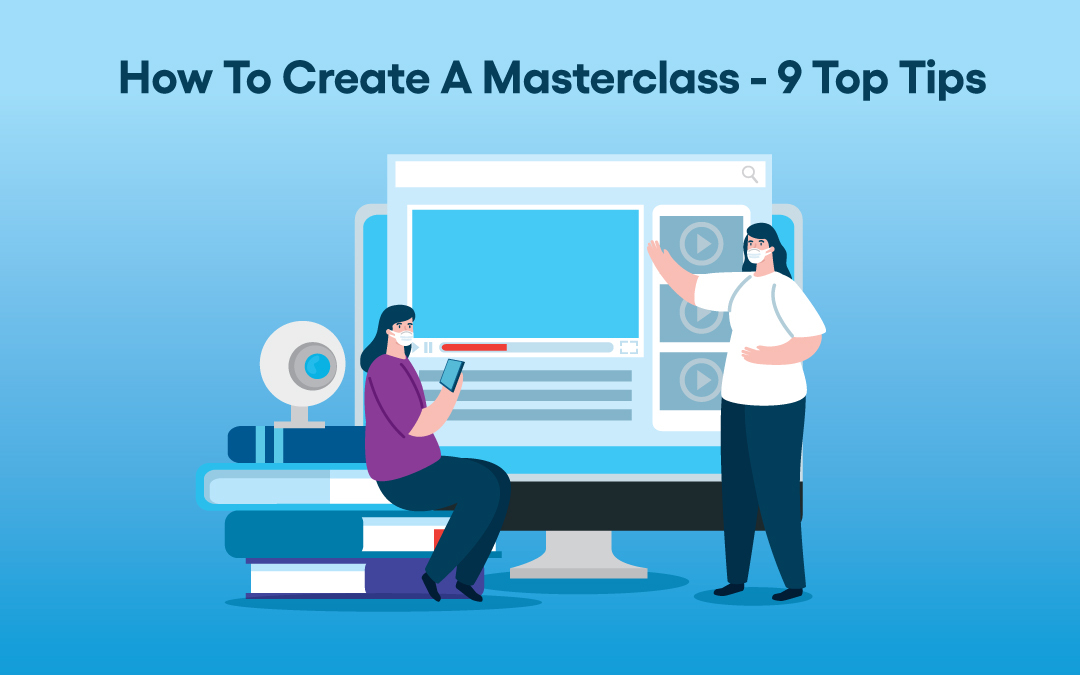You’ve mastered your craft. Now, it’s time to master the art of sharing it. Creating an online masterclass isn’t just about transferring knowledge—it’s about crafting an unforgettable experience. In this guide, we’ll unlock the secrets to transforming your expertise into a self-selling phenomenon. From identifying your audience’s deepest desires to crafting content that captivates and converts, you’ll learn how to build a masterclass that not only educates but inspires action.
What is a Masterclass?
A master class is a specialized course offering expert-level instruction on a specific topic. Unlike typical courses, master classes deliver high-impact content in a concise, engaging format. Masterclasses fit into the broader context of online education by providing high-value content through various instructional methods, such as video, to enhance the learning experience. An effective masterclass has clear learning objectives that guide the content structure and ensure value delivery. At the start of a master class, learners should have an idea of what knowledge
Characteristics of a Successful Masterclass
A successful masterclass stands out from other online courses by embodying several key characteristics. First and foremost, it has a clear and focused learning objective that aligns with the needs and goals of the target audience. This ensures that learners know exactly what they will achieve by the end of the course.
The learning experience is well-structured and engaging, incorporating a mix of video lessons, interactive elements, and hands-on activities. This variety keeps learners interested and helps reinforce the material. High levels of interactivity and engagement are crucial, with opportunities for learners to ask questions, share their thoughts, and receive feedback from the instructor.
A successful masterclass also provides in-depth knowledge and expertise, going beyond surface-level information to offer valuable insights and practical skills. The business model should be sustainable and profitable, with a clear plan for marketing and selling the masterclass.
Finally, a strong brand identity and reputation are essential. A compelling value proposition sets the masterclass apart from other online courses, making it an attractive option for prospective learners.
1. Choose Your Masterclass Topic
Selecting the right topic is key to your masterclass’s success. Begin by listing your skills, passions, and qualifications to clarify what knowledge you’d feel confident sharing with others. Narrow it down to specific themes; for example, in cooking, you might cover kitchen tips or techniques. Engaging topics ensure participants feel they have gained valuable insights and are likely to recommend your masterclass.
Once you have an idea of what themes your masterclass may cover, research your target audience to understand their needs, preferences, and pain points. You can also research other courses covering similar topics to identify market strengths and weaknesses and hone in on your niche.
Identifying Your Target Audience
Identifying your target audience is a critical step in creating a successful masterclass. Understanding who your ideal learners are, what their needs and goals are, and what motivates them to learn will help you tailor your content and approach.
Start by asking yourself questions such as:
– What are the demographics of my ideal learners? (e.g., age, location, occupation)
– What are their goals and aspirations? (e.g., career advancement, personal development)
– What are their pain points and challenges? (e.g., lack of knowledge, limited resources)
– What motivates them to learn? (e.g., desire for personal growth, need for professional development)
– What are their preferred learning styles and formats? (e.g., video, text, interactive)
By answering these questions, you can create a masterclass that is tailored to the needs and goals of your target audience, providing them with a valuable and engaging learning experience.

2. Structure Your Masterclass Content
After choosing your topic, you’ll need to structure your masterclass content. Start by determining what you want attendees to achieve at the end of the class, then work backward. A great way to begin is to define clear learning objectives. These can start with, “At the end of this course, students will be able to…”
You can then divide your masterclass content into logical sections that flow from the main learning objectives you’ve identified. Use a structured approach to help participants follow along and build upon previous sections. As you develop your sections, ensure that you break your learning material into small, manageable segments. That way, students will feel capable and remain motivated to continue on.
Craft Engaging Video Lessons
Video lessons are an integral part of any successful masterclass. This is because many students find that information is easier to digest when there’s a visual element. Essential resources you’ll need for video lessons include a camera, microphone, and editing software for high-quality content. Investing in the right equipment and focusing on engaging video lessons will allow you to deliver a masterclass that captivates your audience and meets their learning needs. Video tutorials can break down skills into manageable lessons and should align with the learners’ goals, integrating seamlessly into your overall content strategy.
Incorporate Interactive Elements
Successful masterclasses often include activities or assessments within each module. To enhance learner engagement and satisfaction, try incorporating interactive elements like polls, live chats, and discussion boards into your activities. Additional elements like quizzes and certifications can further boost engagement.
Provide Downloadable Resources
Downloadable resources support your main content and enhance the learning experience. Some examples of resources you can create and offer include PDFs, slide decks, templates, and study guides. Offering these additional resources gives learners valuable tools to refer to even after the masterclass concludes, which provides them with a more comprehensive and lasting learning experience.
Designing a Compelling Learning Experience
Designing a compelling learning experience is critical to the success of your masterclass. This involves creating an environment that is engaging, interactive, and supportive, providing learners with a valuable and effective learning experience.
Start with high-quality video lessons to provide an engaging and interactive learning experience. Use interactive elements such as quizzes, games, and discussions to keep learners engaged and promote active learning. Hands-on activities like assignments, projects, and case studies offer practical experience and application of the material.
Incorporate live sessions such as webinars, office hours, and Q&A sessions to provide real-time feedback and support. Additionally, use feedback and support mechanisms like email support, discussion forums, and peer review to offer ongoing guidance.
By designing a compelling learning experience, you can create a masterclass that is engaging, effective, and valuable, providing learners with a positive and supportive learning environment.

3. Decide on a Business Model
Imagine your masterclass as a product. You’ve poured your knowledge and passion into creating something valuable. Now, how do you package and sell it? The business model is your answer. With the potential to generate passive income and scale your impact, selecting the right approach is crucial. Building a successful course business through masterclasses can provide significant growth opportunities.
Your earning potential is directly tied to your business model. From a modest $5,000 to a substantial $500,000, the sky’s the limit. By understanding your target audience and their needs, you can create a model that resonates and delivers results.
Subscription-based models often prove lucrative, especially for a series of interconnected masterclasses. Think Netflix for knowledge. For corporate clients, seat licenses or subscriptions can be more profitable than one-time fees.
Pricing is a delicate balance. Consider your masterclass’s value, your target audience’s budget, and the competitive landscape. Are students paying out of pocket or is their company footing the bill? These factors influence what you can charge.
Remember, one size doesn’t fit all. Diversifying your offerings with additional products or services can create multiple income streams.
In essence, your business model is the engine that drives your masterclass. Choosing the right masterclass business model is important for your success. Choose wisely, and you’ll be well on your way to financial success and fulfilling your mission to help others.
Offering Flexible Payment Options
Offering flexible payment options is an important consideration when creating a masterclass. Providing learners with a range of payment options that are convenient, affordable, and flexible can make your masterclass more accessible and attractive.
Consider offering payment plans that allow learners to pay for the masterclass in installments, rather than all at once. Discounts for upfront payments or for learners who are part of a particular group or organization can also be appealing. Scholarships or financial aid options can help those who are unable to afford the masterclass.
Utilize secure payment gateways such as PayPal, Stripe, or Square to provide learners with a convenient and secure way to pay for the masterclass. By offering flexible payment options, you can increase the chances of attracting a diverse and engaged group of learners, making your masterclass more successful.
4. Price Your Masterclass
Pricing your masterclass correctly ensures value for attendees and fair compensation for the instructor. Avoid overcharging, as doing so can scare your audience away before they see what you have to offer! Consider materials, preparation costs, and competitor pricing when deciding on a price.
Market research and the perceived value of content should also guide your pricing decisions. Starting with a lower price can open the doors to more customers, which you can then receive feedback from and adjust accordingly. However, you shouldn’t price your course too low either, as too low of pricing can lead to low expectations.
Masterclasses typically range from $500 to $10,000 or more, depending on topic intricacy and demand. They should have a higher price point than regular online courses due to premium content. Carefully considering these factors can help you set a price that reflects the value of your masterclass and meets learners’ expectations.
5. Create a Masterclass Landing Page
Your masterclass landing page serves as the central hub for operations and sales and is essential for attracting and converting potential learners. Optimizing landing pages can significantly improve conversion rates, aiming for a rate between 5% to 8%, compared to the average of 2.35% across all industries. On this landing page, be sure to include an enticing overview of what learners will gain, along with a striking headline to capture interest.
A brief introduction about the instructor can establish credibility in your course. Other things to highlight on your masterclass landing page include key topics that will be covered, a call-to-action button for course registration, and testimonials to enhance trust.
With an engaging course website, you can convert leads into enrolled students. If you need an effective lead magnet, consider hosting a free mini-course to allow potential students to experience your teaching style and content.

6. Choose a Hosting Platform
You’ll need an efficient hosting platform to manage, promote, and sell your masterclass effectively. Make sure you research platforms and select one that supports your business model and marketing strategy. Primary options include a platform to host online courses, LMS systems, and platforms specifically designed for online masterclasses.
Both online course platforms and LMS systems work well for hosting masterclasses, depending on the masterclass and target audience. Key features to consider when selecting a platform include ease of use, interactive learning functionality, payment options, site performance, and security.
One option for an online course platform is LearnWorlds, which offers video hosting, integration with Zoom/Webex, eCommerce, marketing tools, and interactive content suitable for hosting a masterclass. Teachable is another platform option that provides extensive marketing features and enables creators to grow and engage with their audience effectively.
Podia is a learning platform that supports various digital products, including courses and memberships, all managed through one platform. Kajabi automates marketing with pre-built funnels, which aids in the efficient promotion of online courses. Mighty Networks focuses on community engagement, which allows course creators to foster interaction among members.
By carefully evaluating these options, you can choose a platform that aligns with your needs and helps you deliver a seamless learning experience.
7. Promote Your Masterclass
Getting the word out about your masterclass is as crucial as crafting its content. It’s about connecting with the right people and sparking their interest. Utilizing digital marketing strategies is essential to effectively promote your masterclass and reach a broader audience.
Social media and email marketing are your go-to tools for reaching a wide audience. Share captivating snippets, behind-the-scenes glimpses, and valuable free content to build anticipation. You can also collaborate with influencers or complementary businesses to expand your reach.
Webinars are a powerful way to connect personally with potential students. Through webinars, you can share your expertise, answer questions, and build trust. To create a sense of urgency, try offering exclusive early-bird discounts.
Targeted advertising is another way to find your ideal students. Use platforms like social media or Google Ads to reach people interested in your topic. And don’t forget the power of engaging content! Make sure to share valuable insights, inspiring stories, or practical tips related to your masterclass.
By combining these strategies, you’ll create a buzz around your masterclass and attract a passionate group of learners.
8. Deliver Your Masterclass
Delivering your online masterclass effectively is crucial for delivering a seamless learning experience. The recommended maximum duration for an online masterclass is below three hours. Masterclasses can be conducted through live sessions via platforms like Zoom, pre-recorded videos for lifetime access, or a series of workshops.
Before delivery, ensure that your masterclass aligns with the planned format and that there are no playback errors. Check for a smooth masterclass experience by verifying that there are no media playback errors, login issues, or timeline delays. Utilizing a moderator can enhance participant engagement by managing questions and facilitating discussions. Successful delivery requires practice, maintaining energy, and fostering audience interaction.
Recommended tools for delivering a live online masterclass include Facebook, YouTube Live, Zoom Premium, GoToWebinar, WebinarJam, and ClickMeeting. A reliable and stable internet connection can ensure an uninterrupted streaming experience.
By following these guidelines, you’ll be able to host a masterclass that provides a valuable and engaging learning experience for your participants.
9. Gather Feedback and Improve
Customer feedback is central to a successful masterclass. By actively seeking and incorporating student input, you can continuously enhance your course content and delivery.
To gather rich, actionable insights, include open-ended questions in your feedback forms. This allows students to share detailed thoughts and suggestions. Analyzing this feedback will help you pinpoint areas for improvement and ensure that each subsequent masterclass is better than the last.
Remember, a masterclass is an evolving product. By placing a high value on student experience, you’ll create a learning journey that consistently exceeds expectations.

Summary
From concept to launch and beyond, creating a successful masterclass is a journey that requires careful planning and execution. Every step, from selecting your topic to promoting your course, plays a vital role in crafting an engaging and valuable learning experience.
By following the strategies outlined in this guide, you’ll equip yourself with the tools to build a masterclass that not only educates but inspires. Remember that your journey as a masterclass creator is ongoing. Continuously seek feedback, adapt to your audience’s needs, and stay passionate about sharing your knowledge.
We believe in your ability to create something extraordinary. Now, it’s time to turn your expertise into a thriving online course. Happy teaching!
Frequently Asked Questions
What is the first step to creating a masterclass?
The first step to creating a masterclass is picking a topic that truly connects with your audience and fits your niche. This sets the foundation for a compelling and engaging session.
How do I ensure my masterclass content is engaging?
To keep your masterclass content engaging, try adding interactive elements like quizzes, assignments, and downloadable resources. That way, your audience stays connected and actively participates in the learning process.
What factors should I consider when pricing my masterclass?
To price your masterclass effectively, think about your preparation costs, materials, competitor rates, and the overall value your content offers. This approach will help ensure you’re charging what it’s truly worth.
Which hosting platform is best for my masterclass?
The best hosting platform for your masterclass really depends on what you need, but popular options like LearnWorlds, Teachable, Podia, and Kajabi are great choices to consider. Each one has unique features that can cater to different styles of teaching and audience engagement.
How can I promote my masterclass effectively?
To promote your masterclass effectively, leverage social media, email marketing, and collaborations, and consider offering early-bird discounts. This approach will help you maximize visibility and attract more students!
Spotlightr Video Hosting For Your Course
Discover why Spotlightr is the #1 choice for course creators and e-learning professionals.
Register for a free 2 week trial, no credit card required.

